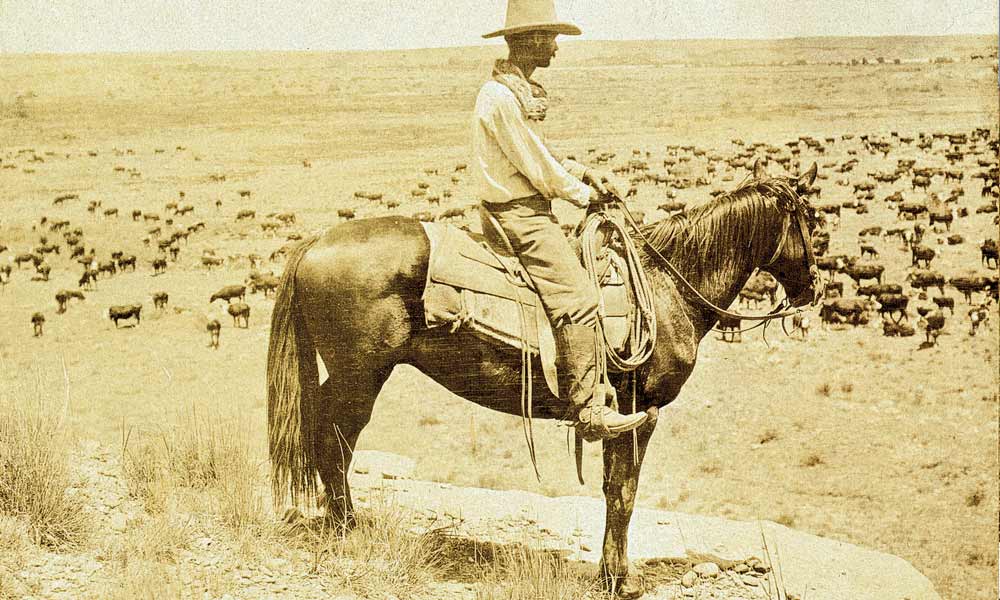
– Courtesy Wittliff Collections, Texas State University –
Making the film should have been easy. Movies from Larry McMurtry’s novels—1963’s Hud and 1971’s The Last Picture Show—had already earned five Oscars when, in 1972, The Last Picture Show Director Peter Bogdanovich tried to package McMurtry’s new Western screenplay. The story of retired Texas Rangers on a cattle drive was then titled Streets of Laredo (a title McMurtry would reuse). They had signed James Stewart as Gus and Henry Fonda as Jake Spoon. But when John Wayne turned down the part of Woodrow Call, the deal fell through.
More than a decade—and five Oscars (for 1983’s Terms of Endearment)—later, McMurtry bought back his script from the studio, expanded the story into a novel and, this time, all of the stars aligned properly. Motown Productions was best known for shows with a black music core, like 1975’s Mahogany and 1978’s The Wiz, but production head Suzanne De Passe read the pre-publication (and pre-Pulitzer) galleys and amazed everyone by purchasing the rights.
She hired Texas-centric writer and director William Wittliff, who had made three Westerns with Willie Nelson, 1980’s Honeysuckle Rose, 1982’s Barbarosa and 1986’s Red Headed Stranger, to adapt the novel into a miniseries. Sydney-born Australian Simon Wincer, who had shown a penchant for frontier-based movies and would become a Westerns specialist—witness the excellent 1990 Western Quigley Down Under—was signed to direct. A rich supporting cast was bolstered by the leads, Robert Duvall and Tommy Lee Jones.
Today, Lonesome Dove is widely recognized as the best Western ever made for television. Many count it among the half-dozen best Westerns of any medium. While Lonesome Dove never played on the big screen, its astonishing ratings and video sales revitalized Westerns. Without this miniseries, would we have had 1990’s Dances With Wolves, 1992’s Unforgiven and 1993’s Tombstone?
Lonesome Dove was a high-water mark in the careers of most of the folks involved. Ricky Schroder was just coming off five seasons on the sitcom Silver Spoons when he landed the role of Newt, the illegitimate son of Tommy Lee Jones’s character, Call.
“I was 17, and I turned 18 making Lonesome Dove,” Schroder says. “Newt was a career-changing role. It helped me grow from a teenaged—heartthrob was your word—into part of an iconic Western piece of history. It helped me immensely. It is, in my opinion, one of the best five Westerns ever made.”
Why has Lonesome Dove lasted? De Passe gave the reason when she spoke at Rob Word’s luncheon marking Lonesome Dove’s 25th anniversary: “I was always fighting the guys, Simon Wincer and [Producer] Dyson Lovell, saying you can’t take out the two little pigs following the wagon, you can’t take out Clara begging Gus to stay, because that was the romance of the piece. And if I was anything, I was the romance cop when it came to editing. Lonesome Dove appealed to women and men in equal measure, and that is why it stood the test of time.”
To celebrate the novel and the film, a series of events will take place from January through July, in eight institutions in and around Fort Worth, Texas, under the title “Lonesome Dove Reunion and Trail.” The centerpiece will be a reunion of cast and crew, on Thursday, March 31, at the River Ranch in the Fort Worth Stockyards. Actors expected to join the celebration include Duvall, Jones, Diane Lane, Anjelica Huston, Schroder and Glenne Headly. From behind the camera, de Passe, Wittliff, Wincer and many more. The reunion is a benefit for the Wittliff Collections, located at Texas State University and devoted to collecting, preserving and sharing the creative legacy of the Southwest through literature, photography, film and music.
Cast and crew panel discussions will take place at Texas Christian University and the Amon Carter Museum of American Art.
The Fort Worth Library will host a symposium about the history of the cattle trails, titled “Vaqueros, Cowboys and Cowgirls: Texas Cattle Trails to the World.”
At the Cattle Raisers Museum, inside the Fort Worth Museum of Science and Industry, “Photographs From Lonesome Dove” will include many of the stunning images Wittliff took during the shoot.
The Sid Richardson Museum will feature “Lonesome Dove: The Art of Story.” Paintings and bronzes by Frederic Remington and Charles Russell will be juxtaposed with the production art of Lonesome Dove.
The National Cowgirl Museum and Hall of Fame will present “Bullets and Bustles: Costumes of Lonesome Dove,” along with props and sketches from the miniseries.
A selection of costumes, props and photographs will make up “Lonesome Dove: Highlights of the Wittliff Collections” at the Old Jail Center in Albany.
Most important, on March 28 and March 29, the Lonesome Dove miniseries will be presented as it should be, but as few have ever seen it: on a big screen, under the stars in Sundance Square.
FILM REVIEW
Jane Got a Gun
Jane Got a Gun is the movie too tough to die. Natalie Portman stars as a woman forced to protect her gut-shot hubby from a vengeful gang, aided by her former fiancé. Jane Got a Gun lost its first director on day one, then a succession of big-name stars and, on the eve of release, its original producer and distributor went bankrupt. Yet the film is a triumph, packed with strong performances, explosive action and fresh takes on clichéd situations. This winter, the Weinstein Company has directed most of its efforts toward promoting Quentin Tarantino’s The Hateful Eight, but the studio has a gem in this little-Western-that-could, a sobering tale worth seeing.
Visit LonesomeDoveReunion.com for schedule of events. Henry C. Parke is a screenwriter based in Los Angeles, California, who blogs about Western movies, TV, radio and print news: HenrysWesternRoundup.Blogspot.com






